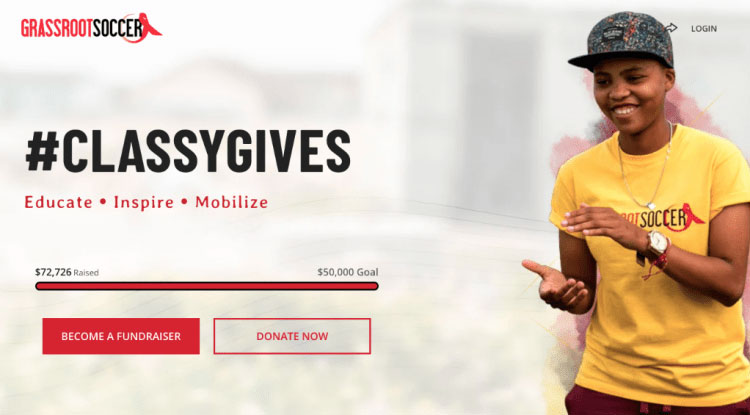8 Ways to Make It Easy for Peer-to-Peer Fundraisers to Crush Their Goals

This post is written by Audrey Phillips, program manager at Classy.
A successful peer-to-peer fundraising campaign requires thoughtful planning and a strong understanding of how to motivate your fundraisers to crush their goals. At Classy, we put our own fundraising skills to this test with our annual #ClassyGives initiative, where our staff collectively fundraises for a nonprofit organization. In 2019, we fundraised for Grassroot Soccer—an organization that leverages the power of soccer to educate, inspire, and mobilize at-risk youth in developing countries—and exceeded our $60,000 goal and raised a total of $72,000.
As a Classy employee, I helped coordinate our past peer-to-peer employee campaign. I chat with our customers every day about fundraising best practices and was previously on the development team at a nonprofit, so this was a great opportunity to practice what I preach all day. Below, I share how I managed this campaign and motivated our staff to hit our goals.

Free Guide: Anatomy of a Succesful Peer-to-Peer Campaign
1. Be Thoughtful About Your Campaign Pages, Goals, and Timeline
Before launching a peer-to-peer campaign, make sure the campaign itself is set up and ready to go. The more work you can do before publicly launching, the more time you’ll have to focus on communicating with your donors and fundraisers. Our team created a Classy peer-to-peer campaign using Grassroot Soccer’s messaging and branding. One thing that makes a peer-to-peer campaign unique, however, is the individual and team fundraising pages.
While fundraisers are always encouraged to personalize these, we’ve found that many simply do not have the time. They end up keeping the templated language and design on the page. That’s why we added in a general profile picture and some text around the organization’s impact beforehand, all in the voice of the fundraiser, so that the page is engaging even if it’s not updated by the individual fundraisers.
It was also important for us to set an overall fundraising goal for the campaign and a timeline for reaching that goal. Using past ClassyGives campaigns as a benchmark, we set our goal at $50,000. We purposely set a more conservative goal so that our staff could feel the motivating rush of achieving it, and then we could push to exceed the original goal. We decided to run a six-week campaign so that our fundraisers had plenty of time to sign up and reach out to their connections for donations.
2. Kick-Start Your Campaign on a High Note
Getting your community—and in our case, an entire company—excited to fundraise is no easy task, and it’s important to kick-start the campaign with some serious energy. First, we thought it was crucial for our employees to understand more about Grassroot Soccer. It’s nearly impossible to successfully fundraise for a cause you don’t fully believe in, so we brought in Molly McHugh, Grassroot Soccer’s Communications Director. Molly came and spoke to our entire company about their programs, where funding was most needed, and even had us perform some soccer drills they do with their kids.
Having an event to officially launch the campaign helped increase excitement and engagement from our staff. Immediately after Molly’s presentation, I sent a company-wide email with instructions on how to sign up as a fundraiser. We had already asked for volunteers to act as team captains, so after individuals signed up they were assigned to specific teams.
Even if you’re not able to host an event for your public campaign launch, find other ways to boost anticipation and excitement. The main goals are to make sure your constituents are ready to fundraise, understand the impact they will have, and have the tools needed to be successful. Try doing a drip email campaign that has a countdown to the campaign launch. This can go hand in hand with a countdown on social media, both in the newsfeed as well as utilizing the story features on Facebook and Instagram.
3. Lean On Your Team Captains
An important element of our success was setting up fundraising teams and the dedication of our team captains. The perfect candidates were employees that were ready to fundraise themselves and excited to motivate their team to participate since they are essentially acting as fundraising cheerleaders. As a nonprofit running a peer-to-peer campaign, I recommend reaching out to your most loyal and engaged supporters which could be your major donors, volunteers, board members, or staff.
Keep in mind, that you don’t have to use teams if it doesn’t quite make sense for your fundraising base. As a company with many individuals personally invested in nonprofit work, we had tons of people who were excited to act as team captains as well as a community of people who would motivate one another as they competed to help their team raise as much money as possible.
The main benefit of using teams in a peer-to-peer campaign is the ability to lean on your team captains to communicate with fundraisers. While it’s great to have some messages come from the person or staff leading the overall campaign, communication from team captains can often feel more personal and hold fundraisers more accountable.
As a leader at your nonprofit, you can empower your captains with the types of messages they can relay to their teams. Below is a sample email I sent to our captains, complete with a template they could use to motivate and equip their team members.
“Hi Team Captains,
We’re well on our way into fundraising and I am LOVING all the success I’m seeing through your teams! HUGE shoutout to Team Sarah who is in the lead with $6,599 raised, and Alison and Phil who are on our individual leaderboard—plus Gabe who is not far behind! Keep up the great work!
I thought it would be helpful to provide an email template to send out to your team members. Totally optional to send, particularly if you have been in frequent communication already. But if you want an easy copy and paste, have at it!
TEMPLATE TO SEND TO TEAM MEMBERS:
Hi Team,
We are now well on our way into #ClassyGives! Congratulations on an amazing February, and I can’t wait to watch our team DOMINATE the competition in March! Big shoutout to our top fundraiser on the team, ENTER NAME, keep it up!!
I thought it would be helpful to provide some tips to get the ball rolling with our fundraising:
- Customize your story on your fundraising page. Make it more personal to you (i.e. your connection to soccer, teens, nonprofits, Classy, etc.). Don’t be shy in adding some images and GIFs in as well to make it more dynamic!
- Email is still the best way to get donations. Start sending personal emails to individuals, or at least smaller groups of people. This is more of a direct ask compared to posting on social media, and more formal than sending texts.
- Don’t be afraid to ask more than once. People need that reminder and extra nudge to take action!
- While email is key, keep chugging along on social media. It’s great for advocacy, and you never know who will give after seeing it! Pro tip: tag your top donors in the post as a shoutout. Not only does it show recognition, but it can also expose your post to their followers, thus making you more visible!
- For people who you know can’t afford a large gift, make a more targeted ask that makes it easier to give. For example: “My old jersey number was 23, so this year I’m asking for $23 to my fundraiser. If even half of you gave $23, I would be at X amount!”
You guys rock! Keep up the great work and please don’t hesitate to come to me with any questions!
Download: Guide to Peer-to-Peer Fundraising Emails
4. Equip Fundraisers to Overcome the Mid-Campaign Slump
Fundraising activity often slows down mid-campaign, and your fundraisers on the ground can feel it. By the middle of our campaign, our fundraisers had reached out to their main pool of connections and were a bit stuck with what to do next. I offered the suggestion of encouraging their closest connections to reach out to their networks, and—most importantly—included a template for our fundraisers to copy and paste.
“Hi Fundraisers,
It’s official. The honeymoon phase is over and we’re in that mid-campaign slump… Have no fear though, it happens with every peer-to-peer campaign. You’ve reached out to your close friends and family and posted on social a few times, and it probably feels like you’ve gotten whatever donations you’re going to get. But have you reached out to the connections of your connections? That’s the beauty of peer-to-peer fundraising!
A huge majority of the donations I received came from friends of my family, and I didn’t even directly ask them. I asked my parents to email their friends on my behalf because I knew it would carry more weight coming from them. To make things easy for them, I still wrote the email, so all my parents had to do was copy and paste!
Even better, here is the email I wrote. Please feel free to copy, enter in your personal touches, and fire away:
TEMPLATE SEND TO ANYONE AND EVERYONE ON YOUR BEHALF:
Hi XX,
As you may already know, FUNDRAISER’S (YOUR NAME) company, Classy, creates software for nonprofits to harness their potential in online fundraising. Their mission is to mobilize and empower the world for good, and part of that means putting their money where their mouth is and actively fundraising for a nonprofit every year.
This year, they’ve selected Grassroot Soccer. They are an awesome organization that was founded by two professional “futball” players from Zimbabwe. Essentially, they noticed that mortality rates were decreasing for all age groups except adolescents, particularly in Eastern/Southern Africa. They decided to use soccer to teach adolescents, primarily girls, about the dangers of HIV, how to protect themselves from STIs and sexual abuse, and how to build confidence beyond their teenage years!
FUNDRAISER’S NAME is personally super excited about this organization because as S/HE puts it: “Grassroot Soccer is targeted in their impact. They found one really big problem, and found one creative and relevant way to appeal to teenagers.”
Check out this video to learn more about them.
If you’d like to make a donation to FUNDRAISER’S fundraising page, click [ENTER YOUR LINK]. If S/HE raises $3,000, S/HE could qualify for a trip to one of their programs in South Africa! S/HE also asked me to say that S/HE knows we are all inundated with requests for donations these days, so S/HE completely understands if you’re tapped on your charitable contributions. Please feel free to share HIS/HER link with anyone else you think may be interested!
Thank you so much from myself and FUNDRAISER’S NAME!”
Social media was a great tool to spread information on Grassroot Soccer and ask for donations. With the help of the organization’s communication team, we crafted several sample posts for Facebook and Instagram that our fundraisers could copy and paste as their own. Here is one of the posts we sent out:
“Every day, 1,000 adolescent girls and young women are infected with HIV. In Sub-Saharan Africa, girls account for 74% of new infections among adolescents. But here’s the good news: after going through Grassroot Soccer programming, adolescent girls are more likely to test for HIV, more likely to leave physically and emotionally abusive relationships, and more likely choose relationships that have greater levels of gender equality and trust, while boys show improved attitudes towards gender equality.
[Insert personal language around fundraising campaign link]”
Create different templates for each social media channel and either share them directly with your fundraisers or ask your team captains to send them along to their teams. Remember, your goal is always to make it as easy as possible for your fundraisers to be successful.
6. Provide Incentives for Fundraisers
While it’s amazing to collectively fundraise for a stellar cause, it’s not always easy to ask friends and family for donations. Sometimes your fundraisers need an extra boost of motivation through campaign incentives, which can be helpful in keeping up the momentum.
The top incentive for our campaign was that the 10 fundraisers who raised the most money would fly out to visit Grassroot Soccer’s programs and see the impact of their dollars raised, in person. However, we also came up with weekly prizes that we would announce at the start of each week. These included a Sonos speaker, a Kindle, donations from Classy to their fundraising page, a camping kit, a Fitbit, and a team-sponsored happy hour.
Consider the types of incentives that you can regularly sprinkle into your campaign or at critical junctures like the mid-campaign lull. You can also switch up the qualifications for winning the prizes too, such as whoever raised the most over a specific weekend, whoever had the most donors, or a raffle of anyone who had raised over $250. Everyone in our campaign was pleasantly surprised when they won any of these prizes, and these were a huge factor in keeping up fundraising morale.
7. When in Doubt, Communicate
If you haven’t noticed by now, a huge factor in successfully leading a peer-to-peer campaign is consistent communication. It’s easy to focus all your communication efforts on your launch, but it’s equally important to build a cadence with your fundraisers (and donors) to ensure they are staying up to date and keeping the campaign top of mind.
After the initial launch, we sent fundraisers an email every Monday highlighting the campaign progress, fundraising leaderboard, weekly prize winner, and upcoming incentive. We also paired each email with a short message in our company Slack account. I sent weekly emails to the team captains with templated emails or social media posts they could then send to their team members. Finally, I hosted weekly fundraising office hours for anyone who wanted to learn more about best practices for fundraising. These in-person meetups proved to be great opportunities to dig deeper into an individual’s fundraising strategy.
Set your team up for success by building out a schedule of communications for both your fundraisers and your team captains, clearly noting the purpose and providing content for each message. You can also use tools like Facebook Live or Zoom to host fundraising “office hours” or Q&A sessions during which your supporters can get more insights.
Download: Understanding the True Financial Potential of Peer-to-Peer Fundraising
8. Follow Up With Third-Party Donors
The power of peer-to-peer fundraising campaigns is the large number of new donors it brings to an organization. I worked closely with Grassroot Soccer to ensure they were providing proper follow-up and stewardship with any donors new to the campaign. Along with the Classy donation receipt each donor received, Grassroot Soccer’s Founder and CEO also sent a personal thank you email.
“Dear [Donor Name],
You are amazing! Thank you for your donation of [$X Amount] to Grassroot Soccer on [date] in honor of [Fundraiser Name]. Your generous gift provides role models, health education, life skills, and linkages to health services to young people in Africa at a critical point in their lives.
While young people in Africa face great health challenges, they are also the greatest force for change. Your support makes it possible for GRS to use the power of soccer to empower youth with the knowledge, skills and support they need to live healthy, productive lives.
If you haven’t already, we’d love it if you’d join our online community by following us on Facebook, Twitter, Instagram, or YouTube—whichever platforms you prefer. You’ll get the latest news, photos, and video from the field.
Thank you for investing in the future of youth in Africa…it couldn’t be done without you!
Sincerely,
Thomas S. Clark, M.D.
Founder and CEO”
Grassroot Soccer even took it a step further and called every donor—no matter their gift size. Most of the time they left voicemails, so it didn’t take much time, and it was a great personal touch to make the donor feel appreciated. It was a big step forward in turning new one-time donors into regular donors.
As a nonprofit team, make a concerted effort to thank your third-party donors and then wrap them into your email welcome series. Encourage your fundraisers to also reach out personally to their donors, whether through a coordinated thank you card-making opportunity at your office or a simple reminder to email or call their donors. To foster a sense of community with our fundraisers and again, make it fun and easy, I hosted a “thank you card” evening where our fundraisers could get together to write thank you cards to their donors to share some love.
With proper planning and communication, you can help ensure your fundraisers’ success, which directly impacts yours. Provide them with the tools they need to win donations, new donors, and new advocates for your organization.

The Anatomy of a Successful Peer-to-Peer Campaign



